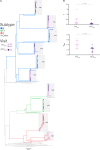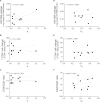Reduction of HIV-1 Reservoir Size and Diversity After 1 Year of cART Among Brazilian Individuals Starting Treatment During Early Stages of Acute Infection
- PMID: 30804915
- PMCID: PMC6378917
- DOI: 10.3389/fmicb.2019.00145
Reduction of HIV-1 Reservoir Size and Diversity After 1 Year of cART Among Brazilian Individuals Starting Treatment During Early Stages of Acute Infection
Abstract
The aim of early combined antiretroviral therapy (cART) of HIV is to limit the seeding of the viral reservoir during the initial phase of infection and, consequently, decrease intrahost viral diversity. Here, we assessed the effect of early cART on size and complexity of the proviral reservoir. Peripheral blood mononuclear cell (PBMC) and plasma samples were obtained from ten HIV-infected Brazilian individuals diagnosed at the acute phase of infection, before (PREART) and 12 months (M12ART) after suppressive cART. HIV proviral reservoir size was determined by quantitative real-time PCR; intrahost viral diversity of the env C2-V3 region was assessed by single genome amplification or next-generation sequencing in PBMC and plasma, respectively. Mean nucleotide diversity (π) and normalized Shannon entropy (HSN) were used to infer the complexity of the viral population. Compared to PREART, M12ART saw an immunological recovery with a gain of ∼200 CD4+ T cells (P = 0.008) and a normalization of the CD4/CD8 ratio [1.0 (IQR: 0.88-1.18), P = 0.016], as well as a significant decrease in HIV-1 RNA (∼4 log, P = 0.004) and DNA (∼1 log, P = 0.002) levels. The median time to achieve viral suppression was 3 months (IQR: 2.8-5.8 months). The high intermixing between sequences from both visits suggests that the HIV-1 DNA reservoir remained remarkably stable under cART. After 1 year of cART, there was a minor reduction in proviral π (PreART = 0.20 vs. M12ART = 0.10; P = 0.156) but a significant decrease in HSN (PreART = 0.41 vs. M12ART = 0.25; P = 0.019). We found no correlation between π or HSN at PreART and the rate of HIV DNA decay, T CD4+ counts, or CD4/CD8 ratio at M12ART. Based on a small cohort of Brazilian infected individuals under early cART and analyses of the env region, 1 year of follow-up suggested a reservoir size reduction, allowed a significant decrease of HIV-1 complexity, and achieved immunological restoration regardless of the initial HIV-1 plasma viral load, CD4+ T cell counts, or HIV-1 subtype. However, further studies in the Brazilian setting aiming a longer follow-up and larger cohort are required in this field.
Keywords: HIV-1; acute infection; diversity; early cART; reservoir.
Figures




References
-
- Abrahams M.-R., Anderson J. A., Giorgi E. E., Seoighe C., Mlisana K., Ping L.-H., et al. (2009). Quantitating the multiplicity of infection with human immunodeficiency virus type 1 subtype C reveals a non-poisson distribution of transmitted variants. J. Virol. 83 3556–3567. 10.1128/JVI.02132-08 - DOI - PMC - PubMed
-
- Archin N. M., Vaidya N. K., Kuruc J. D., Liberty A. L., Wiegand A., Kearney M. F., et al. (2012). Immediate antiviral therapy appears to restrict resting CD4+ cell HIV-1 infection without accelerating the decay of latent infection. Proc. Natl. Acad. Sci. U.S.A. 109 9523–9528. 10.1073/pnas.1120248109 - DOI - PMC - PubMed
LinkOut - more resources
Full Text Sources
Research Materials
Miscellaneous

